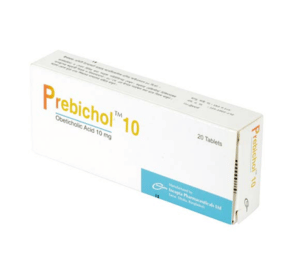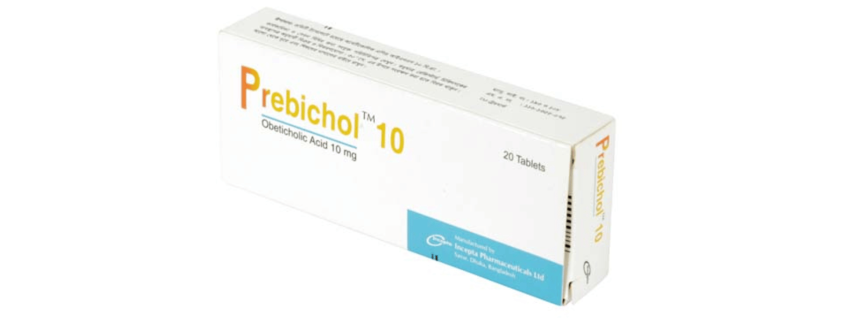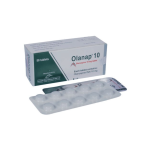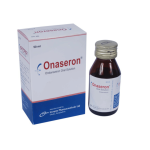Prebichol(Obeticholic Acid)

Therapeutic Group: Farnesoid Receptor Agonist
Presentation
Prebichol 5 tablet: Each tablet contains Obeticholic Acid INN 5 mg.
Prebichol10 tablet: Each tablet contains Obeticholic Acid INN 10 mg.
Description
Obeticholic Acid is an agonist for farnesoid receptor (FXR), a nuclear receptor expressed in the liver and intestine. FXR is a key regulator of bile acid, inflammatory, fibrotic, and metabolic pathways. FXR activation decreases the intracellular hepatocyte concentrations of bile acids by suppressing de novo synthesis from cholesterol as well as by increased transport of bile acids out of the hepatocytes. These mechanisms limit the overall size of the circulating bile acid pool while promoting choleresis, thus reducing hepatic exposure to bile acids. Obeticholic acid increases bile flow from the liver and suppresses bile acid production in the liver, thus reducing the exposure of the liver to toxic levels of bile acids.
Indications
Obeticholic Acid is indicated for the treatment of primary biliary cholangitis (PBC) in combination with ursodeoxycholic acid (UDCA) in adults with an inadequate response to UDCA, or as monotherapy in adults unable to tolerate UDCA.
Dosage & Administration
Important Dosage and Administration Instructions
• Prior to the initiation of Obeticholic Acid in patients with suspected cirrhosis, use the monogram to calculate the patient’s score to determine their Child-Pugh classification (A, B, or C) and determine the appropriate starting dosage.
• Routinely monitor patients during Obeticholic Acid treatment for biochemical response, tolerability, progression of PBC disease, and re-evaluate Child-Pugh classification to determine if dosage adjustment is needed.
• Reduce the dosing frequency from once daily to once weekly as appropriate for patients who progress to advanced disease (i.e., from Child-Pugh Class A to Child-Pugh Class B or C).
Recommended Dosage Regimen
The recommended starting dose and titration dosage regimen of Obeticholic Acid for patients who have not achieved an adequate biochemical response to an appropriate dosage of
UDCA for at least 1 year or are intolerant to UDCA is dependent upon disease stage.
Monitoring for Safety, Treatment Discontinuation
• Routinely monitor patients during Obeticholic Acid treatment for progression of PBC disease.
• Reduce the dosing frequency for patients who progress from Child-Pugh Class A to Child-Pugh Class B or C
• Close monitoring is recommended for patients at an increased risk of hepatic decompensation,
• Interrupt treatment with Obeticholic Acid in patients with worsening of liver function indicating risk of decompensation, and monitor the patient’s liver function.
• Consider discontinuing Obeticholic Acid in patients who have experienced clinically significant liver-related adverse reactions.
Management of Patients with Intolerable Pruritus on Obeticholic Acid
For patients with intolerable pruritus on Obeticholic Acid consider one or more of the following management strategies:
For Non-Cirrhotic or Compensated Cirrhotic Child-Pugh Class A Patients:
• Add an antihistamine or bile acid binding resin
• Reduce the dosage of Obeticholic Acid to:
– 5 mg every other day, for patients intolerant to 5 mg once daily.
– 5 mg once daily, for patients intolerant to 10 mg once daily.
• Temporarily interrupt Obeticholic Acid dosing for up to 2 weeks. Restart at a reduced dosage. For patients whose dosage is reduced or interrupted, titrate the dosage based on biochemical response, tolerability and adjust according to Child-Pugh classification.
For Child-Pugh Class B or C or Patients with a Prior Decompensation Event:
• Add an antihistamine or bile acid binding
• Temporarily interrupt Obeticholic Acid dosing for up to 2 weeks. Restart at a reduced dosage if applicable. Titrate the dosage based on biochemical response, tolerability and adjust according to Child-Pugh classification.
Treatment Discontinuation
Consider discontinuing Obeticholic Acid treatment in patients who continue to experience persistent, intolerable pruritus despite management strategies.
Administration Instructions
Obeticholic Acid can be taken with or without food. For patients taking a bile acid binding resin, take Obeticholic Acid at least 4 hours before or 4 hours after taking the bile acid binding resin, or at as great an interval as possible.
Side Effects
Most common adverse reactions (≥ 5%) are: pruritus, fatigue, abdominal pain, rash, oropharyngeal pain, dizziness, constipation, arthralgia, thyroid function abnormality, and eczema.
Precautions
Routinely monitor patients for progression of PBC disease, including liver-related complications, with laboratory and clinical assessments. Dosage adjustment, interruption, or discontinuation may be required. Discontinue in patients who develop complete biliary obstruction. Monitor for changes in serum lipid levels during treatment.
Use in Pregnancy & Lactation
Pregnancy:
The limited available human data on the use of Obeticholic Acid during pregnancy are not sufficient to inform a drug-associated risk. In animal reproduction studies, no developmental abnormalities or fetal harm was observed.
Nursing mothers:
There is no information on the presence of Obeticholic Acid in human milk, the effects on the breast-fed infant or the effects on milk production. The developmental and health benefits of breastfeeding should be considered along with the mother’s clinical need for Obeticholic Acid.
Drug Interaction
Bile acid binding resins such as cholestyramine, colestipol, or colesevelam adsorb and reduce bile acid absorption and may reduce the absorption, systemic exposure, and efficacy of Obeticholic Acid. The International Normalized Ratio (INR) decreased following coadministration of warfarin and Obeticholic Acid. Obeticholic acid may increase the exposure to concomitant drugs that are CYP1A2 substrates. Avoid concomitant use of inhibitors of the bile salt efflux pump (BSEP) such as cyclosporine.
Over Dose
In the case of overdosage, patients should be carefully observed and supportive care administered, as appropriate.
Storage
Do not store above 30C. Keep away from light and out of the reach of children.
Commercial Pack
Prebichol TM 5 tablet: Each box contains 2 blister strips of 10 tablet.
Prebichol TM 10 tablet: Each box contains 2 blister strips of 10 tablet.



